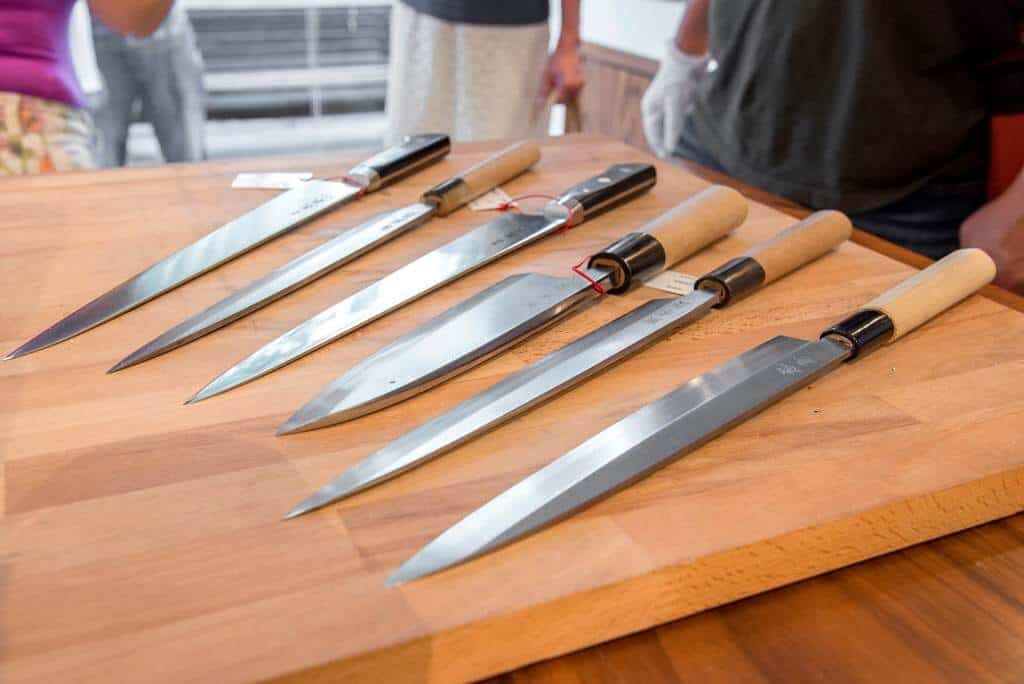Traditional Yanagiba Knife- the symbol of the Japanese cut

Yanagiba is a knife that resembles a willow leaf, and many call it Shobu (Iris Leaf). It is the most popular filleting knife in the Middle East; you will stumble upon it in every sushi bar. It is originally designated for cutting fish sashimi from one side only, for the perfect cut.
These knifes are not suitable for western sawing, but for a one drag smearing only, thus its length ranges from 21 to 34 cm.
In order to achieve its goal, the Yanagiba has been designed to be long and narrow with a smooth surface and an extremely sharp unidirectional blade (on the right side). The other side is a bit curved in order to prevent from the fish to get glued to the blade. In order to get the perfect cut the blade has to penetrate deeply until it reaches the center of the fish.
For sharpness purposes, these knives were made from a quality carbon steel in the past, combined with two types of steel: a solid external surface and an internal core, which was softer.
These blades are thicker than the average western knife, but the thinness of the edge delivers the concept of the traditional Japanese knife very well.
Want to compare prices of knives Yanagiba?
The Japanese cut method:
While western knives have been predestined to cut by “pushing” from the edge towards the handle, the Japanese knives have been designed to cut exactly in the opposite way. The pull starts from the handle of the knife towards the edge. A pulling cut is aimed for a more accurate line, and to achieve that a very sharp knife is needed. A pushing cut is easier, stronger and allows cutting meat and bones at once, yet the Japanese method is more accurate and allows a bigger control of the cutting process.
Kiya’s Yanagiba- the Leading Brand in Japan
Kiya was first opened in 1972. The first knife store in Japan by the sword master Isoka Kato. The dynasty keeps the art of creating its knives as a secret, and they export them to certain places in the world only via trust agents.
As opposed to many Japanese families that prefer to compromise on the alloy in order to reduce manufacturing costs, Kiya believes otherwise. Kiya’s Yanagiba line is mostly handmade.
Thus, Kiya’s brand name is linked to greatness nowadays as well, and its knives are widely used by the most famous Japanese chefs and in almost every household in Japan.
In addition, only Kiya’s Yanagiba, thanks to its technological developments in the field, possesses the line of “El-Khaled” Stainless Knives, that are more suitable for professional and modern kitchens, since it is easier to maintain them.

Masamoto’s Yanagiba- the Most Leading Brand in the World
The elders in Japan say that a man named Tomonosuke was born there in 1845. He had dedicated 47 years of his life to learning the secrets behind creating quality knives, and soon after that he formed Masamoto. He told his surroundings: “during my life I have chosen to make kitchen knives and I have dedicated them to learning, which will turn my knives into the best ones, and that is how my name will never be forgotten”. Since then, five generations have been producing and upgrading the Masamoto knives. A traditional soul and a contemporary technique have been put into its production. Therefore, Masamoto has become the best knife in the world. The leading sushi chefs in the world know the brand and its different variations very well.
The knife is produced from a Japanese carbon steel named Shirogami (white steel), with a magnolia wooden handle and a reinforcement ring made of a Buffalo horn. All versions are handmade.
The Yanigaba knives of the KK series, named after Gokukoku, are recommended especially for those that are moving to Japanese knives for filleting for the first time. The blade is made of a spearhead core, high carbon, white Hitachi (Shiroko), with soft iron. The soft wooden magnolia handle with the Buffalo horn symbolizes the knife.
Meet the knives Yanagiba of Masamoto in Hattori.
Want more articles, updates and benefits?

